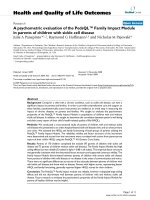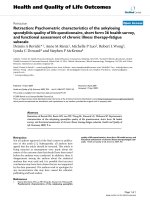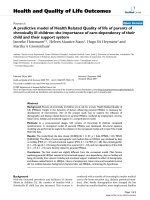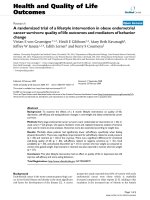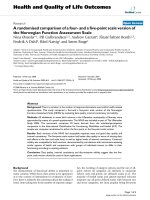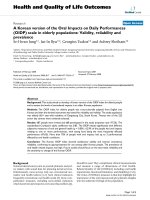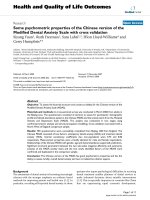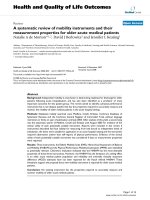báo cáo hóa học: " A psychometric evaluation of the PedsQL™ Family Impact Module in parents of children with sickle cell disease" pptx
Bạn đang xem bản rút gọn của tài liệu. Xem và tải ngay bản đầy đủ của tài liệu tại đây (737.9 KB, 11 trang )
BioMed Central
Page 1 of 11
(page number not for citation purposes)
Health and Quality of Life Outcomes
Open Access
Research
A psychometric evaluation of the PedsQL™ Family Impact Module
in parents of children with sickle cell disease
Julie A Panepinto*
1,2
, Raymond G Hoffmann
1,3
and Nicholas M Pajewski
4
Address:
1
Department of Pediatrics, The Children's Research Institute of the Children's Hospital of Wisconsin/Medical College of Wisconsin,
Milwaukee, WI, USA,
2
Hematology/Oncology/Bone Marrow Transplantation, Medical College of Wisconsin, Milwaukee, WI, USA,
3
Quantitative
Health Sciences, Medical College of Wisconsin, Milwaukee, WI, USA and
4
Section on Statistical Genetics, Department of Biostatistics, University
of Alabama at Birmingham, Birmingham, AL, USA
Email: Julie A Panepinto* - ; Raymond G Hoffmann - ;
Nicholas M Pajewski -
* Corresponding author
Abstract
Background: Caring for a child with a chronic condition, such as sickle cell disease, can have a
significant impact on parents and families. In order to provide comprehensive care and support to
these families, psychometrically sound instruments are needed as an initial step in measuring the
impact of chronic diseases on parents and families. We sought to evaluate the psychometric
properties of the PedsQL™ Family Impact Module in populations of children with and without
sickle cell disease. In addition, we sought to determine the correlation between parent's well being
and their proxy report of their child's health-related quality of life (HRQL).
Methods: We conducted a cross-sectional study of parents of children with and without sickle
cell disease who presented to an urban hospital-based sickle cell disease clinic and an urban primary
care clinic. We assessed the HRQL and family functioning of both groups of parents utilizing the
PedsQL™ Family Impact Module. The reliability, validity and factor structure of the instrument
were determined and scores from the instrument were correlated with scores from parent-proxy
report of their child's HRQL using the PedsQL™ 4.0 Generic Core Scales.
Results: Parents of 170 children completed the module (97 parents of children with sickle cell
disease and 73 parents of children without sickle cell disease). The Family Impact Module had high
ceiling effects but was reliable (Cronbach's alpha > 0.80 in all scales). The empirical factor structure
was generally consistent with the theoretical factor structure and supported construct validity. The
Family Impact Module discriminated between parents of children with severe sickle cell disease
from parents of children with mild disease or no disease in the areas of communication and worry.
There were no significant differences across any of the subscales between parents of children with
mild sickle cell disease and those with no disease. Parents with higher scores, representing better
HRQL and family functioning, generally reported higher HRQL scores for their children.
Conclusion: The PedsQL™ Family Impact module was reliable, however it displayed large ceiling
effects and did not discriminate well between parents of children with and without sickle cell
disease. Future research to evaluate the psychometric properties of the Family Impact Module for
parents of healthy children may be helpful.
Published: 16 April 2009
Health and Quality of Life Outcomes 2009, 7:32 doi:10.1186/1477-7525-7-32
Received: 12 November 2008
Accepted: 16 April 2009
This article is available from: />© 2009 Panepinto et al; licensee BioMed Central Ltd.
This is an Open Access article distributed under the terms of the Creative Commons Attribution License ( />),
which permits unrestricted use, distribution, and reproduction in any medium, provided the original work is properly cited.
Health and Quality of Life Outcomes 2009, 7:32 />Page 2 of 11
(page number not for citation purposes)
Background
Understanding the impact of a chronic disease on a parent
and family of a child with a chronic disease is critical to
providing comprehensive care to these families. However,
the relationship between a child's disease and its course
and the impact on a parent and family is complex and
dynamic. Prior research has shown that caregivers with
children who have a chronic disease experience stress[1],
may have greater family burden[2] and need for social
support[3], and provide more caregiver time with their
children[4]. In addition, a negative parental perception of
a child's health is associated with higher healthcare utili-
zation by the child. [5,6]
Sickle cell disease is a genetic disease usually diagnosed at
birth by newborn screening. It is characterized most com-
monly by frequent, episodic vaso-occlusive painful events
that often result in hospitalizations and missed school by
the child and work by the parent. [7,8] In addition, chil-
dren with sickle cell disease experience central nervous
system complications such as silent and overt stroke
potentially leading to neuro-cognitive deficits. [9,10] Car-
ing for a child with sickle cell disease is thus often met
with unpredictability and family burden due to these
complications. Only one prior study has examined the
impact of sickle cell disease on the health-related quality
of life (HRQL) of parents of children with sickle cell dis-
ease [6]. They found that female caregivers of children
with sickle cell disease displayed lower scores on the
depressive moods, daily activities and vitality subscales of
the TNO-AZL Adult Quality of Life questionnaire [7] com-
pared to socio-economic matched controls. However, this
study was in a Dutch (although primarily immigrant)
population and so it is unclear whether these results trans-
late to caregivers of children with sickle cell disease in the
United States. In addition, it is not known whether there
is an association of a parent's HRQL on the proxy-report-
ing of their child's HRQL in children with sickle cell dis-
ease. In a study of healthy children, parents' HRQL was
shown to correlate with their proxy reporting of the child's
HRQL. [11]
We sought to determine the psychometric properties of
the PedsQL™ Family Impact Module, an instrument
designed to assess the impact of chronic disease on par-
ents and families by examining family functioning and
parent HRQL. In addition, we also compared parent
HRQL with parent-proxy reporting of the child's HRQL in
this population. We expected the PedsQL™ Family Impact
Module to be valid and reliable. We hypothesized that
parents of children with sickle cell disease would have
worse HRQL and family functioning than parents of chil-
dren without sickle cell disease. In addition, we hypothe-
sized that parents with worse HRQL would report that
their child has worse HRQL.
Methods
Study Setting and Subjects
We conducted a cross sectional study of parents of chil-
dren with and without sickle cell disease from January 1,
2006 through June, 2007. Study subjects were eligible if:
1) they had a child ages 2 to 18 years of age with sickle cell
disease who they accompanied to the Midwest Sickle Cell
Center for a routine check up, or 2) they had a child ages
2 to 18 years of age who they accompanied for a routine
check-up at the Downtown Health Center in Milwaukee,
Wisconsin. Children were excluded from the study if they
had an acute illness or were hospitalized within the last
month.
The Midwest Sickle Cell Center serves over 300 children
with sickle cell disease and is based within an academic
children's hospital. The Downtown Health Center is an
urban based clinic that provides primary care to over
4,000 children a year. The majority of patients who regu-
larly attend this clinic are African American (80%) and
have public insurance (92% Medicaid) therefore repre-
senting a similar socio-demographic population to our
families with sickle cell disease. In addition, both the
Sickle Cell Center and the Downtown Health Center serve
patients living in similar zip code areas in the city of Mil-
waukee and thus are comparable in regards to socio-
demographic factors.
Demographic data on the parents and the children were
self reported by the parents and collected through medical
record review. Race data was collected using a modified
United States Census classification and reflect parent
report based on the following choices: White, Black,
Native Hawaiian or Other Pacific Islander, Asian, Ameri-
can Indian or Alaskan native, Other or Unknown.
Parents were asked to report whether they had ever been
told by a health care provider that their child had any of
the following medical conditions: Asthma, chronic aller-
gies/sinus trouble, chronic orthopedic/bone/joint prob-
lems, chronic rheumatic disease, diabetes, epilepsy, or
other chronic medical condition. Patients were classified
as having a medical co-morbidity if they reported one or
more of the above chronic medical conditions.
In addition, parents were asked to report whether they
had ever been told by a health care provider that their
child had any of the following neurobehavioral condi-
tions: anxiety, attentional, or behavioral problems,
depression, developmental delay or mental retardation,
learning problems, or speech problems. Patients were
classified as having a neurobehavioral co-morbidity if
they reported one or more of the above noted neurobe-
havioral conditions.
Health and Quality of Life Outcomes 2009, 7:32 />Page 3 of 11
(page number not for citation purposes)
Lastly, to aid in determining discriminant validity of the
PedsQL™ Family Impact Module in our population of
children with sickle cell disease, we collected data on the
disease status of the children with sickle cell disease. Dis-
ease status was classified a priori as mild or severe disease
regardless of the child's sickle cell genotype. Severe disease
was defined as those children with a history of a sickle cell
related stroke, acute chest syndrome, 3 or more hospitali-
zations in the prior 3 years, or recurrent priapism based
on criteria used for interventions such as hydroxyurea or
bone marrow transplantation and consistent with our
prior work in determining disease severity. [12-16] All
others were classified as having mild disease.
The Institutional Review Board of the Children's Hospital
of Wisconsin/Medical College of Wisconsin approved the
study and informed consent was obtained from the par-
ents.
Outcome Measures
The primary study outcomes were parent HRQL and fam-
ily functioning as measured by the PedsQL™ Family
Impact Module which the parents completed during their
child's health care clinic visit.
PedsQL™ Family Impact Module
The PedsQL™ Family Impact Module [17] assesses parent
HRQL and family functioning and is intended to measure
the impact of a chronic health condition on parents and
families. It has been shown to be reliable and valid in
smaller studies of children with complex special health
care needs and children with cancer. [17,18] There are no
other studies related to the psychometric properties or
development of this instrument to date. The PedsQL™
Family Impact Module consists of 36 items (see last tables
for the items included in the module) that make up 8
scales: physical functioning, emotional functioning,
social functioning, cognitive functioning, communica-
tion, worry, daily activities, and family relationships. Each
item is scored on a 5 point response scale which is then
transformed to a 0 to 100 scale, with higher scores denot-
ing better parent HRQL and family functioning. Mean
scores are then computed by averaging the individual
item scores within a particular subscale.
The Family Impact Module yields 3 summary scores: Total
score, parent health-related quality of life summary score,
and family functioning summary score. The total score is
comprised of the average of the responses to all items in
the questionnaire. The parent HRQL summary score is
determined by averaging the responses to the 20 items
that make up the physical, emotional, social and cognitive
functioning scales noted above. The family functioning
summary score is determined by summing and averaging
the responses to the 8 items that make up the daily activi-
ties and family relationships scales. Missing items were
handled according to the developer's guidelines. [17]
PedsQL™ 4.0 Generic Core Scales
In addition to the PedsQL™ Family Impact Module, each
parent also completed the parent proxy-report of the Ped-
sQL™ 4.0 Generic Core Scales. The PedsQL™ is a 23 item
generic HRQL questionnaire with a proxy report for chil-
dren ages 2 through 18 years. [19] The questionnaire takes
5 to 10 minutes to complete. The questionnaire yields
information on the physical, emotional, social and school
functioning of the child during the previous 4 weeks.
Mean scores are calculated based on a 5-point response
scale for each item and transformed to a 0 to 100 scale
with a higher score representing better quality of life. The
PedsQL™ yields 3 summary scores: a total scale score, a
physical health summary score, and a psychosocial health
summary score. There are 4 scale scores: physical func-
tioning, emotional functioning, social functioning, and
school functioning. The total score is comprised of the
average of all items in the questionnaire. The psychosocial
summary score is comprised of the average of the items in
the emotional, social, and school functioning scales. The
physical health summary score is comprised of the aver-
age of items in the physical functioning scale and is the
same score as the physical functioning score. Missing
items were accounted for based on the developer's recom-
mendation. [19]
The psychometric properties of the PedsQL™ Generic Core
Scales have been extensively studied within populations
with a wide array of chronic health conditions, including
sickle cell disease. [13-20] In contrast, the properties of
the PedsQL™ Family Impact Module have only been dem-
onstrated within populations of children with special
health care needs and cancer. [17,18] Therefore it is
unclear whether the Family Impact Module is a valid and
reliable measure for assessing the impact of SCD on par-
ents and families. We therefore analyzed the following
properties of the PedsQL™ Family Impact Module within
our population of parents, both with and without sickle
cell disease.
Statistical Analysis
Descriptive statistics were calculated for parent and child
characteristics. Categorical variables are presented as
observed frequencies and proportions. Comparisons of
categorical factors were performed using Chi-Square Tests
or Fisher's Exact/Fisher-Freeman-Halton Tests where
appropriate. Mean scores for HRQL were calculated using
the PedsQL™ developer's guidelines. [20] Effect sizes, cal-
culated by taking the differences between means and
dividing by the pooled standard deviation, were done to
show the magnitude of the differences between parents of
children with and without sickle cell disease. Based on
Health and Quality of Life Outcomes 2009, 7:32 />Page 4 of 11
(page number not for citation purposes)
standard accepted criteria, effects sizes were considered
small (0.2), medium (0.5) and large (0.8). [21]
Floor/Ceiling Effects
The percentage of scores on the PedsQL™ Family Impact
Module that were at the ceiling (top of the scale) or floor
(bottom of the scale) were calculated for each subscale
and summary score. A percentage less than 25% was con-
sidered a low ceiling/floor effect. [22,23]
Reliability and Validity
We assessed the internal consistency reliability of the Ped-
sQL™ Family Impact Module to determine whether the
items within each scale were consistent with each other.
This was assessed using Cronbach's alpha for each of the
8 subscales of the PedsQL™ Family Impact Module as well
as for the summary and total scores. A Cronbach's alpha
coefficient of greater than 0.70 was considered acceptable
for group-level analysis. [24]
Validity was determined using a known-groups compari-
son method. To determine the discriminant validity of the
PedsQL™ Family Impact Module, comparisons were made
between parents of children with and without sickle cell
disease. In addition, we also compared parents of children
with sickle cell disease to parents of children without
sickle cell disease and without other co-morbidities to
ensure a comparison to "healthy" children. Because of
skewed distributions, mean summary and subscale scores
for the parents of children with and without sickle cell dis-
ease are reported as medians and interquartile ranges
(IQR). Comparisons of summary and subscale scores
were made using non-parametric Wilcoxon or Kruskal-
Wallis tests.
To further determine the validity of the PedsQL™ Family
Impact Module, an exploratory factor analysis was per-
formed to determine if items correlated as expected for the
scale structure. The factor analysis was based on the poly-
choric correlation matrix due to the ordinal nature of the
module items. Extracted factors were based on the eigen-
value > 1.0 criterion and were rotated using the promax
oblique rotation. All analyses were performed using SAS
v9.1.3 (SAS, Cary, NC).
Correlation Between Family Impact Module and Parent-
proxy PedsQL™ Health-related Quality of Life report
To determine the association between the parent's HRQL
and family functioning with the proxy-report of their
child's HRQL, we examined the correlation between the
scores on the PedsQL™ Family Impact Module with corre-
sponding parent-proxy PedsQL™ HRQL scores. Spearman
rank correlations were used to correlate the summary and
subscale scores from the Family Impact Module with par-
ent-proxy reports of the child's HRQL based on the Ped-
sQL™ Generic Core Scales. Coefficients less than 0.3 in
absolute magnitude were considered indicative of weak
correlation, between 0.3 and 0.5 moderate correlation,
and greater than 0.5 as strong correlation. [21]
Results
We recruited a convenience sample of parents of children
with and without sickle cell disease at both clinics as part
of a larger study of the HRQL of children. [13,25] There
were 145 parents of children with sickle cell disease
approached for the study. Of those, 133 agreed to partici-
pate and 20 refused for varying reasons such as "not
enough time". Ninety-seven parents of children with
sickle cell disease completed both a PedsQL™ Family
Impact module and the generic PedsQL™ parent proxy
report. Ninety-four parents of children without sickle cell
disease were approached at the Downtown Health Center.
Of those, 74 control parents agreed to participate and 73
completed both a PedsQL™ Family Impact module and
generic PedsQL™ parent proxy report.
The majority of respondents were female, the biological
parent and not married (Table 1). Parents of children with
sickle cell disease were older, had higher income, and edu-
cation than parents of children without sickle cell disease.
The majority of parents in each group were African Amer-
ican. A significant number of children from both groups
had other co-morbidities. Slightly more than half of the
children with sickle cell disease were classified as having
severe disease.
Floor/Ceiling Effects in Children with Sickle Cell Disease
The PedsQL™ Family Impact Module demonstrated low
floor effects in all summary and scale scores for both
groups (Table 2). However, moderate to high ceiling
effects were observed for the emotional functioning,
social functioning, cognitive functioning, communica-
tion, daily activities and family relationships subscales. In
parents of children without sickle cell disease, there was
also a moderate ceiling effect in the family functioning
summary scale and the worry scale.
Reliability and Validity
The PedsQL™ Family Impact Module demonstrated
acceptable reliability in all summary scores and all scale
scores in both groups of parents as evidenced by a Cron-
bach's alpha coefficients greater than 0.8 (Table 3). When
we compared scores between children with and without
sickle cell disease as a whole, the groups differed only in
the subscale of worry and there were mild effect sizes
noted in this subscale and the communication subscale
(Table 2). In addition, when we looked for differences in
scores between children 12 years and younger and those
older than 12 years, we did not see any further differences
between groups (data not shown).
Health and Quality of Life Outcomes 2009, 7:32 />Page 5 of 11
(page number not for citation purposes)
Table 1: Demographic Characteristics of the Sample
Parents of SCD children (N = 97) Parents of Control children (N = 73) p-value
Characteristics of the Parents
Age (yrs), median (P25, P75) 37.1 (31.1,40.9) 29.2 (25.9, 35.0) <0.001
Gender N (%) N (%)
Male 7 (7.2) 6 (8.2) 0.967
Female 89 (91.8) 66 (90.4)
Not Reported 1 (1.0) 1 (1.4)
Type of Caregiver
Biological parent 85 (87.6) 55 (75.3) 0.681
Step parent 0 (0.0) 1 (1.4)
Foster parent 0 (0.0) 0 (0.0)
Adoptive parent 2 (2.1) 1 (1.4)
Guardian 6 (6.2) 7 (9.6)
Other 2 (2.1) 1 (1.4)
Not Reported 2 (2.1) 8 (11.0)
Race/Ethnicity
African-American 60 (61.9) 50 (68.5) 0.010
Other 3 (3.1) 14 (19.2)
Not Reported 34 (35.1) 9 (12.3)
Family Income
< $20 K 37 (38.1) 34 (46.6) 0.032
≥ $20 K but <$40 K 24 (24.7) 13 (17.8)
≥ $40 K 21 (21.7) 5 (6.9)
Not Reported 15 (15.5) 21 (28.8)
Marital Status
Married 23 (23.7) 21 (28.8) 0.604
Not Currently Married 62 (62.9) 44 (60.3)
Not Reported 12 (12.4) 8 (11.0)
Highest Education Level
Some High School or less 20 (20.6) 28 (38.4) 0.0315
High School diploma/GED 29 (29.9) 12 (16.4)
Vocational/some college 31 (32.0) 24 (32.9)
College/graduate degree 8 (8.3) 3 (4.1)
Not Reported 9 (9.3) 6 (8.2)
Work Status
Working 56 (57.7) 10 (13.7) <0.001
Not Working 31 (32.0) 56 (76.7)
Not Reported 10 (10.3) 7 (9.6)
Characteristics of Children
Age (yrs), median (P25, P75) 10.0 (5.0, 14.0) 7.0 (3.0, 11.0) 0.005
Gender
Female 52 (53.6) 41 (56.2) 0.740
Medical Co-morbidities
Any 27 (27.8) 34 (46.6) 0.012
Asthma 20 (20.6) 27 (37.0)
Chronic Allergies 6 (6.2) 11 (15.1)
Diabetes 1 (1.0) 1 (1.4)
Chronic Orthopaedic, Bone, or Joint Problems 8 (8.3) 3 (4.1)
Health and Quality of Life Outcomes 2009, 7:32 />Page 6 of 11
(page number not for citation purposes)
When we compared scores of parents of children with
mild sickle cell disease or severe sickle cell disease to par-
ents of children without sickle cell disease, there were sig-
nificant differences in the communication and worry
scales of the module with mild or moderate effect sizes
noted in these subscales and in the daily activities sub-
scale. (Table 4). Specifically, parents of children with
severe sickle cell disease reported significantly worse
scores in the communication and worry scales than chil-
dren with mild sickle cell disease and children without
sickle cell disease.
In our subset analysis (Figure 1) we analyzed the follow-
ing groups for differences in scores: 1) sickle cell disease
without co-morbidities (n = 47), 2) sickle cell disease with
neurobehavioral co-morbidities (n = 23), 3) sickle cell
disease with medical co-morbidities (n = 12), 4) sickle cell
disease with neurobehavioral and medical co-morbidities
(n = 15), and 5) healthy, urban controls (n = 23). Chil-
dren without sickle cell disease and without other co-mor-
bidities tended to have higher scores across most of the
subscales and children with sickle cell disease and medical
and neurobehavioral co-morbidities tended to have the
lowest scores. However, similar to our analysis above, we
found statistically significant differences only in the worry
and communication subscales.
Correlation Between Family Impact Module and Parent-
proxy PedsQL™ Health-related Quality of Life report
We compared parent proxy HRQL scores for the child[13]
to the parent's HRQL scores on the PedsQL™ Family
Impact Module and found they were significantly corre-
Epilepsy 4 (4.1) 1 (1.4)
Rheumatic Disease 1 (1.0) 0 (0.0)
Other 2 (2.1) 4 (5.5)
Neuro-behavioral Co-morbidities
Any 38 (39.2) 34 (46.6) 0.334
Anxiety Problems 6 (6.2) 9 (12.3)
Attentional Problems 22 (22.7) 17 (23.3)
Behavioral Problems 19 (19.6) 17 (23.3)
Depression 7 (7.2) 6 (8.2)
Developmental Delay or Mental Retardation 4 (36.4) 7 (63.6)
Learning Problems 21 (21.7) 14 (19.2)
Speech Problems 9 (9.3) 10 (13.7)
Sickle Cell Disease Status
Mild disease 44 (45.5) NA
Severe disease 53 (54.6) NA
P25 and P75: 25% and 75% percentile
Table 1: Demographic Characteristics of the Sample (Continued)
Table 2: Scale Descriptives of the PedsQL™ 2.0 Family Impact Module in Children with Sickle Cell Disease and Urban Controls
Sickle Cell Disease Controls
Scale N Median (IQR) %Floor/%Ceiling N Median (IQR) %Floor/%Ceiling Effect Size p-value*
Total Score 95 75.7 (60.8, 86.8) 0.0/4.2 73 75.7 (62.5, 91.3) 0.0/6.8 -0.061 0.549
Parent HRQL 97 75.0 (61.3, 90.0) 0.0/6.2 72 74.4 (59.7, 90.0) 0.0/9.7 0.052 0.793
Family Functioning 94 75.0 (62.5, 93.8) 1.1/19.1 68 81.3 (63.1, 100.0) 0.0/27.9 -0.072 0.414
Physical Functioning 95 66.7 (50.0, 87.5) 1.1/13.7 72 70.8 (54.2, 91.7) 0.0/18.1 -0.139 0.374
Emotional Functioning 97 75.0 (60.0, 100.0) 0.0/26.8 73 75.0 (60.0, 100.0) 0.0/27.4 0.022 0.763
Social Functioning 96 87.5 (62.5, 100.0) 1.0/42.7 72 81.3 (60.9, 100.0) 0.0/37.5 0.133 0.337
Cognitive Functioning 96 75.0 (60.0, 100.0) 1.0/30.2 72 75.0 (53.8, 96.3) 0.0/25.0 0.194 0.234
Communication 94 83.3 (66.7, 100.0) 1.1/39.4 72 91.7 (75.0, 100.0) 1.4/47.2 -0.221 0.108
Worry 94 65.0 (45.0, 90.0) 1.1/18.1 71 80.0 (52.5, 100.0) 0.0/33.8 -0.275 0.040
Daily Activities 93 75.0 (50.0, 100.0) 3.2/28.0 69 75.0 (50.0, 100.0) 0.0/40.6 -0.120 0.431
Family Relationships 94 80.0 (61.3, 100.0) 1.1/34.0 68 87.5 (65.0, 100.0) 1.5/33.8 -0.015 0.869
*p-value from Wilcoxon Rank-Sum Test
IQR: Inter-quartile Range
Health and Quality of Life Outcomes 2009, 7:32 />Page 7 of 11
(page number not for citation purposes)
lated (Table 5). The correlations were moderate for par-
ents of children with sickle cell disease and moderate to
high for parents of children without sickle cell disease.
Factor Analysis
Table 6 shows the results of the exploratory factor analysis
performed with the PedsQL™ Family Impact Module. Our
analysis found 5 factors (latent constructs). Four of the
factors generally corresponded to the physical function-
ing, cognitive functioning, worry, and family relation-
ships scales. However, two social functioning items "feel
isolated from others" and "trouble getting support from
others", a communication item "feel others don't under-
stand my family's situation", and three emotional func-
Table 3: Internal Consistency Reliability of the PedsQL™ Family Impact Module in Children with Sickle Cell Disease and Urban
Controls
Scale Total Sample Sickle Cell Disease Sample Control Sample
Total Score 0.96 0.96 0.97
Parent HRQL Summary Score 0.95 0.94 0.95
Family Functioning Summary Score 0.92 0.92 0.93
Physical Functioning 0.90 0.89 0.92
Emotional Functioning 0.85 0.86 0.86
Social Functioning 0.83 0.86 0.81
Cognitive Functioning 0.92 0.94 0.91
Communication 0.80 0.81 0.80
Worry 0.89 0.89 0.89
Daily Activities 0.86 0.88 0.84
Family Relationships 0.94 0.95 0.92
Values denote Cronbach's α coefficient
Table 4: Comparison of Parent Health-related Quality of Life and Family Functioning in Children With Sickle Cell Disease and Urban
Controls
Controls
a
Mild SCD
b
Severe SCD
c
Scale N Median (IQR) N Median (IQR)
Effect Size
†
N Median (IQR)
Effect Size
†
Differences*
Summary Scores
Total Score 73 75.7 (62.5, 91.3) 44 78.8 (67.4, 91.3) 51 73.6 (57.4, 83.6)
-0.109-0.211
Parent HRQL 72 74.4 (59.4, 90.0) 44 78.8 (65.4, 93.1) 53 73.5 (60.0, 84.7)
-0.168-0.051
Family Functioning 68 81.3 (61.8, 100.0) 44 76.6 (68.8, 98.4) 50 75.0 (56.3, 93.8)
0.038 -0.165
Dimensions
Physical Functioning 72 70.8 (54.2, 91.7) 43 66.7 (50.0, 91.7) 52 68.8 (50.0, 77.1)
-0.100 -0.173
Emotional Functioning 73 75.0 (60.0, 100.0) 44 80.0 (70.0, 100.0) 53 70.0 (60.0, 90.0)
0.185 -0.111
Social Functioning 72 81.3 (59.4, 100.0) 44 93.8 (68.8, 100.0) 52 87.5 (59.4, 100.0)
0.186 0.085
Cognitive Functioning 72 75.0 (52.5, 97.5) 44 92.5 (60.0, 100.0) 52 75.0 (55.0, 90.8)
0.335 0.066
Communication 73 91.7 (75.0, 100.0) 44 95.8 (66.7, 100.0) 50 66.7 (58.3, 100.0) a, b > c
-0.024 -0.403
Worry 72 80.0 (50.0, 100.0) 44 77.5 (50.0, 100.0) 50 55.0 (40.0, 80.0) a, b > c
0.003 -0.532
Daily Activities 70 75.0 (50.0, 100.0) 44 75.0 (58.3, 100.0) 49 66.7 (50.0, 91.7)
-0.001 -0.225
Family Relationships 68 87.5 (65.0, 100.0) 44 85.0 (62.5, 100.0) 50 80.0 (60.0, 100.0)
0.071 -0.088
* Differences based on Kruskal-Wallis Tests followed by pair-wise Wilcoxon tests if global null hypothesis was rejected
Health and Quality of Life Outcomes 2009, 7:32 />Page 8 of 11
(page number not for citation purposes)
tioning items "feel sad", "feel angry", and "feel helpless or
hopeless" loaded together on the fifth factor.
Discussion
The PedsQL™ Family Impact Module demonstrated good
reliability and indicated that parents of children with
sickle cell disease may experience more worry and diffi-
culty with communication surrounding issues related to
their child's health. The questionnaire did not differenti-
ate parents of children with sickle cell disease from those
without disease in any other area. The empirical factor
structure deviated some from its theoretical expectation
particularly in terms of the emotional and social function-
ing, daily activities, and communication subscales. The
large proportion of ceiling effects across both study
groups suggests that the questionnaire may not be sensi-
tive enough for parents of children in our groups.
Only one prior study has examined the HRQL of parents
of children with sickle cell disease. [26] Conducted in the
Netherlands, this study found that parents of children
with sickle cell disease have worse HRQL than Dutch par-
ents of children from a normative population and to a
control group that was matched on socioeconomic status.
Our parents of children without sickle cell disease were
younger and more likely to not be working and have
lower family income compared to our parents of children
with sickle cell disease. Although a significant number of
our children without sickle cell disease had a chronic ill-
ness such as asthma, our subgroup analysis of those with-
out co-morbidities did not demonstrate any additional
differences between our two groups. Lastly, it has been
shown that urban children from poor socioeconomic
areas have low HRQL that is similar to the HRQL of chil-
dren with a chronic disease [27] but there are no similar
data on this in the parents of children with chronic dis-
ease.
Two prior studies utilizing the PedsQL™ Family Impact
Module found significant differences between groups in
the parents' HRQL and family functioning. [17,18] In a
Table 5: Spearman Correlations between PedsQL™ Family Impact Module Summary Scores and PedsQL™ Parent-Proxy Report
Summary Scores
Parents of children with SCD
PedsQL™ Family Impact Module
PedsQL Parent-Proxy Report Total Score Parent HRQL Family Functioning
Total Score 0.456 0.390 0.373
(<0.001) (<0.001) (<0.001)
Psychosocial Health 0.467 0.382 0.403
(<0.001 (<0.001) (<0.001)
Physical Health 0.389 0.356 0.278
(<0.001) (<0.001) (0.007)
Parents of control children
PedsQL™ Family Impact Module
PedsQL Parent-Proxy Report Total Score Parent HRQL Family Functioning
Total Score 0.603 0.539 0.481
(<0.001) (<0.001) (<0.001)
Psychosocial Health 0.649 0.608 0.649
(<0.001) (<0.001) (<0.001)
Physical Health 0.403 0.320 0.398
(<0.001) (0.006) (0.001)
Number in parentheses denotes p-value for testing H
0
: ρ = 0
Median Summary and Scale Scores for PedsQL™ Family Impact ModuleFigure 1
Median Summary and Scale Scores for PedsQL™
Family Impact Module. A Comparison of Parents of
Healthy Children without Sickle Cell Disease to Children
with Sickle Cell Disease.
40
50
60
70
80
90
100
To
t
al
S
c
or
e
P
ar
en
tH
R
Q
L
F
a
m
i
l
y
F
unct
i
on
i
ng
P
hys
i
c
al F
un
ct
i
oni
n
g
E
mot
i
o
nal F
un
ct
i
oni
n
g
S
oci
al F
unct
i
oni
n
g
C
ogn
i
t
i
v
e
F
unct
i
o
ni
n
g
*
W
o
r
r
y
‡
C
o
m
mun
i
c
at
i
on
D
ai
l
y
A
ct
i
vi
t
i
es
F
a
mi
l
y
R
el
at
i
onshi
ps
Median Scale Score
Healthy Children without SCD (n=23) a SCD: No comorbidities (n=47) b
SCD: Behavioral Only (n=23) c SCD: Medical Only (n=12) d
SCD: Behavioral + Medical (n=15) e
*
p 0.01, a>c, d, e & b>e
‡
p 0.01 a>d, e & b>e
Health and Quality of Life Outcomes 2009, 7:32 />Page 9 of 11
(page number not for citation purposes)
group of children with complex health conditions, par-
ents who cared for a child at home had significantly worse
HRQL and family functioning on the Family Impact mod-
ule compared to parents whose child resided in a long
term convalescent home. [17] A recent study of Brazilian
children with cancer reported worse parent HRQL and
family functioning in parents whose children were receiv-
ing outpatient chemotherapy compared to parents whose
children were receiving inpatient chemotherapy. [18]
Both of these studies reported much higher effect sizes
than demonstrated in our study and demonstrated
expected known group differences, namely that caring for
a child with a chronic condition and medical needs at
home results in worse parent HRQL and worse family
functioning. In addition, both of these prior studies com-
pared caregivers of children with similar illnesses in both
Table 6: Promax Rotated Factor Loadings for PedsQL™ Family Impact Module
Factor
Item IIIIIIIVV
Physical Functioning tired during day 0.075 -0.035 0.932 0.061 -0.116
tired in the morning 0.014 -0.039 0.942 0.000 -0.018
too tired to do things I like -0.025 0.078 0.925 0.010 -0.034
get headaches -0.018 -0.199 0.689 -0.036 0.388
feel physically weak -0.089 0.097 0.837 0.210 -0.092
feel sick to my stomach -0.126 -0.087 0.504 0.405 0.169
Emotional Functioning feel anxious -0.131 0.076 0.306 0.429 0.207
feel sad -0.048 0.057 -0.131 0.244 0.806
feel angry -0.043 -0.125 0.074 0.381 0.677
feel frustrated 0.415 -0.140 0.183 -0.002 0.495
feel helpless or hopeless 0.189 0.110 -0.035 -0.036 0.752
Social Functioning feel isolated from others 0.149 0.117 0.191 -0.016 0.555
trouble getting support from others 0.176 0.188 0.072 0.029 0.544
hard to find time for social activities 0.138 0.150 0.402 0.011 0.361
enough energy for social activities -0.006 0.246 0.387 0.192 0.256
Cognitive Functioning hard to keep my attention on things 0.081 0.200 0.192 0.635 -0.083
hard to remember what people tell me 0.092 -0.006 0.127 0.825 0.009
hard to remember what I just heard 0.214 0.012 0.026 0.782 0.049
hard to think quickly 0.073 0.185 -0.095 0.753 0.124
trouble remembering what I was just thinking 0.201 -0.087 0.070 0.676 0.128
Worry whether child's medical treatments are working -0.126 0.850 0.013 0.041 0.179
side effects of my child's medications -0.120 0.886 -0.060 0.205 0.018
how others will react to my child's condition 0.051 0.854 -0.108 0.285 -0.130
my child's illness affects other family members 0.121 0.767 0.036 -0.060 0.039
about my child's future 0.005 0.869 -0.002 -0.162 0.102
Communication feel others don't understand my families situation -0.027 0.389 -0.047 -0.073 0.666
hard to talk about my child's health -0.107 0.528 -0.047 0.145 0.434
hard to tell doctors and nurses how I feel 0.167 0.305 -0.021 0.249 0.339
Family Relationships lack of communication between family members 0.848 -0.031 -0.044 0.064 0.099
conflicts between family members 0.911 -0.027 0.019 0.065 -0.059
difficulty making decisions together as a family 0.890 0.042 -0.045 0.103 -0.013
difficulty solving family problems together 0.904 0.103 -0.048 0.077 -0.016
stress or tension between family members 0.930 -0.188 -0.109 0.138 0.144
Daily Activities family activities take more time and effort 0.450 0.512 0.247 -0.046 -0.174
difficulty finding time to finish household tasks 0.490 0.330 0.301 -0.187 0.085
feeling too tired to finish household tasks 0.406 0.372 0.219 -0.085 0.131
Total Variance Explained = 78.2%
Highlighted cells denote factor loadings > 0.50
Results based on n = 139 with complete responses to all items
Health and Quality of Life Outcomes 2009, 7:32 />Page 10 of 11
(page number not for citation purposes)
groups. Our population included a group of parents
whose children had sickle cell disease and compared their
well being to parents whose children did not have sickle
cell disease. All of the children in our study resided in their
parents' home.
There are no prior studies that have utilized the PedsQL™
Family Impact Module to determine the HRQL or family
functioning of parents who do not have a child with a
chronic illness. Therefore, there is unfortunately a current
lack of normative data. The parents in our study were
drawn from clinics that largely serve patient populations
from minority race/ethnic groups and impoverished back-
grounds. In addition, the parents may have stressors
related to their socioeconomic status which in and of itself
places these parents at risk for poor HRQL and decreased
family functioning. Lastly, the control group represents
families presenting to their primary care doctor for a rou-
tine well child check up which may introduce selection
bias in that sample. It will therefore be of future interest to
determine whether the parents in both our study groups
display depressed HRQL and family functioning com-
pared to a normative population. It will also be of interest
to investigate the impact of socio-demographic factors on
parent HRQL and family functioning as assessed by the
PedsQL™ Family Impact Module. Further work utilizing
the PedsQL™ Family Impact Module will help clarify this.
We did demonstrate that the HRQL of the parents corre-
lated significantly with the parents'rating of their child's
HRQL. That is, when a parent's HRQL was higher, the par-
ent rated their child's HRQL higher. Prior studies have
reported similar findings and underscore the importance
of understanding a parents' well being when measuring a
child's HRQL and the parent is a proxy-reporter. [11,28]
Similar to two prior studies that examined the reliability
of the PedsQL™ Family Impact Module in other chronic
diseases, we found the questionnaire to be very reliable.
[17,18] Our Cronbach's alpha coefficients were all greater
than the minimum expected for group level analysis (0.7)
and many exceeded the level needed for an individual
level analysis (0.9). [29]
We noted a large ceiling effect in many scales of the mod-
ule. This implies that the module may not be sensitive to
parents who are doing well presently and would not be
able to demonstrate further improvement in the parents
over time in each of these different scale areas. However,
we saw little evidence of floor effects, which implies that
the measure would be responsive to detecting further
deterioration in a parent's HRQL and family functioning.
The PedsQL™ Family Impact Module should be investi-
gated within the context of longitudinal studies, both for
parents of healthy children and those with chronic health
conditions, to evaluate its sensitivity to changes over time.
A number of limitations should be considered in evaluat-
ing these study results. The parents were involved in the
study during a routine clinic visit and so the reported
scores are not in direct response to a disease exacerbation,
such as a vaso-occlusive pain event requiring hospitaliza-
tion. Future research will be required to assess the short
term impact of such events on parents and families. In
addition, our parents of children without sickle cell dis-
ease may have had burdens other than having a child with
chronic disease that resulted in our two groups looking
similar in parent HRQL and family functioning when all
children were included in the analysis. Unfortunately, we
were limited by our sample size to explore this issue fur-
ther. Lastly, our parents came from one geographical area
and may not generalize to other regions.
Conclusion
The PedsQL™ Family Impact Module is a reliable tool and
demonstrated that parents of children with sickle cell dis-
ease experience more worry and report problems with
communication regarding their child's health compared
to children without sickle cell disease. The questionnaire
did not demonstrate differences between parents of chil-
dren with and without sickle cell disease in other areas of
family functioning and parent HRQL. Further work to
establish normal scores on this measure may be helpful in
elucidating the true effect of chronic disease in popula-
tions of parents who have a child with a chronic disease.
Abbreviations
HRQL: health-related quality of life
Competing interests
The authors declare that they have no competing interests.
Authors' contributions
JP designed study, acquired and interpreted data, and
drafted manuscript. RH aided in study design, supervision
and interpretation of data analysis, and revised the manu-
script. NP aided in study design, analyzed and interpreted
the data, and revised the manuscript.
Acknowledgements
This work was supported by grants from the National Institutes of Health
(Dr. Panepinto K23 HL80092-01 and GCRC grant M01-RR00058). Dr.
Pajewski is supported by grant number T32 HL072757 from the National
Institutes of Health.
References
1. Lawoko S, Soares JJ: Quality of life among parents of children
with congenital heart disease, parents of children with other
diseases and parents of healthy children. Qual Life Res 2003,
12:655-666.
Publish with BioMed Central and every
scientist can read your work free of charge
"BioMed Central will be the most significant development for
disseminating the results of biomedical research in our lifetime."
Sir Paul Nurse, Cancer Research UK
Your research papers will be:
available free of charge to the entire biomedical community
peer reviewed and published immediately upon acceptance
cited in PubMed and archived on PubMed Central
yours — you keep the copyright
Submit your manuscript here:
/>BioMedcentral
Health and Quality of Life Outcomes 2009, 7:32 />Page 11 of 11
(page number not for citation purposes)
2. Sales E: Family burden and quality of life. Qual Life Res 2003,
12(Suppl 1):33-41.
3. Helgeson VS: Social support and quality of life. Qual Life Res
2003, 12(Suppl 1):25-31.
4. Moskowitz JT, Butensky E, Harmatz P, et al.: Caregiving time in
sickle cell disease: psychological effects in maternal caregiv-
ers. Pediatr Blood Cancer 2007, 48:64-71.
5. Campo JV, Comer DM, Jansen-Mcwilliams L, Gardner W, Kelleher KJ:
Recurrent pain, emotional distress, and health service use in
childhood. J Pediatr 2002, 141:76-83.
6. Janicke DM, Finney JW, Riley AW: Children's health care use: a
prospective investigation of factors related to care-seeking.
Med Care 2001, 39:990-1001.
7. Brandow AM, Brousseau DC, Panepinto JA: Postdischarge pain,
functional limitations and impact on caregivers of children
with sickle cell disease treated for painful events. Br J Haema-
tol 2009, 144(5):782-8.
8. Panepinto JA, Brousseau DC, Hillery CA, Scott JP: Variation in hos-
pitalizations and hospital length of stay in children with vaso-
occlusive crises in sickle cell disease. Pediatr Blood Cancer 2005,
44:182-186.
9. Swift AV, Cohen MJ, Hynd GW, et al.: Neuropsychologic impair-
ment in children with sickle cell anemia. Pediatrics 1989,
84:1077-1085.
10. Schatz J, Brown RT, Pascual JM, Hsu L, DeBaun MR: Poor school
and cognitive functioning with silent cerebral infarcts and
sickle cell disease. Neurology 2001, 56:1109-1111.
11. Cremeens J, Eiser C, Blades M: Factors influencing agreement
between child self-report and parent proxy-reports on the
Pediatric Quality of Life Inventory 4.0 (PedsQL) generic core
scales. Health Qual Life Outcomes 2006, 4:58.
12. Panepinto JA, O'Mahar KM, DeBaun MR, Rennie KM, Scott JP: Valid-
ity of the child health questionnaire for use in children with
sickle cell disease. J Pediatr Hematol Oncol 2004, 26:574-578.
13. Panepinto JA, Pajewski NM, Foerster LM, Hoffmann RG: The per-
formance of the PedsQL generic core scales in children with
sickle cell disease. J Pediatr Hematol Oncol 2008, 30:666-673.
14. Charache S, Terrin ML, Moore RD, et al.: Effect of hydroxyurea on
the frequency of painful crises in sickle cell anemia. Investi-
gators of the Multicenter Study of Hydroxyurea in Sickle
Cell Anemia. N Engl J Med 1995, 332:1317-1322.
15. Scott JP, Hillery CA, Brown ER, Misiewicz V, Labotka RJ: Hydroxyu-
rea therapy in children severely affected with sickle cell dis-
ease. J Pediatr 1996, 128:820-828.
16. Walters MC, Patience M, Leisenring W, et al.: Bone marrow trans-
plantation for sickle cell disease. N Engl J Med 1996,
335:369-376.
17. Varni JW, Sherman SA, Burwinkle TM, Dickinson PE, Dixon P: The
PedsQL Family Impact Module: preliminary reliability and
validity. Health Qual Life Outcomes 2004, 2:55.
18. Scarpelli AC, Paiva SM, Pordeus IA, Varni JW, Viegas CM, Allison PJ:
The pediatric quality of life inventory (PedsQL) family
impact module: reliability and validity of the Brazilian ver-
sion. Health Qual Life Outcomes 2008, 6:35.
19. Varni J: The PedsQL™ 4.0 Measurement Model for the Pedi-
atric Quality of Life Inventory™ Version 4.0: Administration
Guidelines. 2004 [ />].
20. Varni JW: The PedsQL™ Scoring Algorithm: Scoring the
Pediatric Quality of Life Inventory™. 2007, 2007: [http://ped
sql.org/score.html].
21. Cohen LaH M: Statistics for social scientists. London: Harper
and Row; 1982.
22. Varni JW, Burwinkle TM, Seid M: The PedsQL 4.0 as a school
population health measure: feasibility, reliability, and valid-
ity. Qual Life Res 2006, 15:203-215.
23. Raat H, Landgraf JM, Oostenbrink R, Moll HA, Essink-Bot ML: Relia-
bility and validity of the Infant and Toddler Quality of Life
Questionnaire (ITQOL) in a general population and respira-
tory disease sample. Qual Life Res 2007, 16:445-460.
24. Varni JW, Burwinkle TM, Seid M, Skarr D: The PedsQL 4.0 as a
pediatric population health measure: feasibility, reliability,
and validity. Ambul Pediatr 2003, 3:329-341.
25. Panepinto JA, Pajewski NM, Foerster LM, Sabnis S, Hoffmann RG:
Impact of family income and sickle cell disease on the health-
related quality of life of children. Qual Life Res 2009, 18(1):5-13.
Epub 2008 Nov 7
26. Tweel XW van den, Hatzmann J, Ensink E, et al.: Quality of life of
female caregivers of children with sickle cell disease: a sur-
vey. Haematologica 2008, 93:588-593.
27. Mansour ME, Kotagal U, Rose B, et al.: Health-related quality of
life in urban elementary schoolchildren. Pediatrics 2003,
111:1372-1381.
28. Price MR, Bratton DL, Klinnert MD: Caregiver negative affect is
a primary determinant of caregiver report of pediatric
asthma quality of life. Ann Allergy Asthma Immunol 2002,
89:572-577.
29. Spilker B: Quality of Life and Pharmacoeconomics in Clinical
Trials. Lippincott Williams and Wilkins; 1996.


